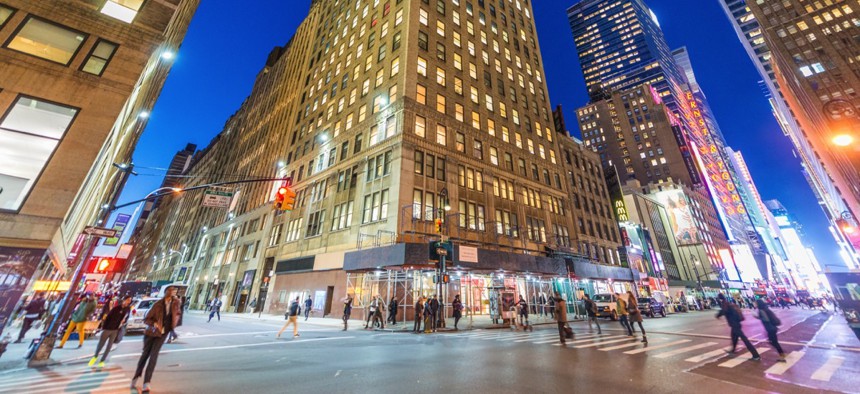New York City's Wi-Fi Kiosks Now Include a 'Yelp for Social Services'

New York City, New York.
The move targets New Yorkers who stand to benefit most from the LinkNYC network in the first place.
There’s no blueprint for how to roll out the world’s largest free public wi-fi network—especially one with hundreds of web-beaming, touch-screen towers spread across five boroughs. So a little more than a year after LinkNYC installed its first kiosks around New York City, some questions are still hazy. How are they supposed to be used? Who are they really meant for?
Today LinkNYC’s purpose takes a slightly clearer shape, with the addition of Aunt Bertha, an existing app modeled as a Yelp for social safety-net services run by an Austin-based benefit corporation. LinkNYC kiosks are already equipped with access to 911 and 311, a portal to apply for government benefits, interactive maps, free phone-call capabilities, and a USB charger. Through a simple search from one of the kiosk tablets, New Yorkers can now tap into Aunt Bertha’s robust database of food pantries, emergency housing, childcare, healthcare, transportation assistance, and financial aid programs located within that zip code.
The app targets the New Yorkers who stand the most to gain from LinkNYC’s services in the first place. A 2015 study by the city comptroller’s office found that roughly 813,000 households (nearly 26 percent, citywide) lacked broadband access at home; 510,000 don’t have a computer.
The majority of these disconnected households are surviving below the poverty line, and may benefit from the resources Aunt Bertha is designed to catalogue and serve up with ease. Founded in 2012, the platform has connected more than 280,000 people around the U.S. with services from all tiers of government, large nonprofit agencies, and neighborhood groups—the sorts of resources otherwise buried across thousands of websites and pamphlets that can require hours or days of sifting to find.
“People in need are almost always grappling with interrelated problems… so easily accessible powerful technology tools that provide useful options in one place are key,” Steve Lee, a managing director at Robin Hood, a New York City anti-poverty agency, said in a statement.
Whether New Yorkers will bite, of course, is the big-ticket question. LinkNYC has logged more than a million registered users on its wi-fi network since the kiosks first rolled out in February 2016. However, the offerings have shifted substantially: Initially, the touch-screens offered unfettered web-browsing, but that feature quickly got axed when the lure of YouTube (and porn sites) proved too disruptive to sidewalk life. And not all New Yorkers have taken enthusiastically to the 2001 Space Odyssey-like monoliths, which are owned and operated by a consortium of public and private entities with Alphabet at the center. Data privacy concerns, especially in low-income neighborhoods already experiencing disproportionate levels of police surveillance, have held plenty of users back.
Representatives for LinkNYC say that the kiosks themselves don’t require log-ins (though the wi-fi network does), and wipe any personal information entered at the end of each session. Usage data from the Aunt Bertha app, they say, will be aggregated to guide searchers to services that might be the most in-demand where they are. LinkNYC also continues to work with community groups, local libraries, youth groups, and seniors organizations to reach groups that could benefit from the services. Meanwhile, the network will continue to expand. Currently, there are a little over 800 kiosks around the city; LinkNYC expects 7,500 total by 2025.
“Smart” technology will never solve wicked problems like urban poverty, hunger, transportation gaps, and healthcare divides on its own—focused policies and targeted investments have to work in tandem. But if the yank-back of LinkNYC’s web browsing access was a case study in unintended consequences of overly broad ambitions, a move to connect more New Yorkers with specific services is a step in a helpful direction.
Laura Bliss is a staff writer at CityLab, where this article was originally published.
NEXT STORY: Mayors Rally Residents to Conserve More Than 1.9 Billion Gallons of Water





